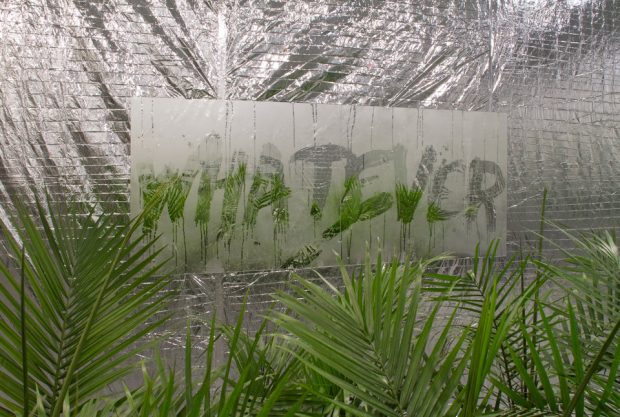Jeffrey Michael Austin, just recently turned the Chicago Artists Coalition space into a real-life greenhouse. Potted palm plants, UV grow lights, and reflective mylar—all play a role within a controlled heat and humidity environment, to bring to life an unconventional art exhibition that negotiates issues of intimacy, identity, place, and belonging. “Stay alive” forces the viewer to wander around the spread of soil and to look at their reflections on misted mirrors, fogged up with steam, amidst deviously thought out words and patterns. Scribbles spelling out words like, “whatever” or “forever,” and doodles in the shape of clouded abstract forms convey the feeling that one is in a steamed bathroom—an almost claustrophobic setting conducive to channeling inner thoughts and processing emotions. Some kind of safe space.
The interdisciplinary artist, musician and educator, is determined to reshape and reimagine the viewer’s’ notion of space inside and outside of the gallery setting—and even within oneself. Blurring the lines between reality and illusion, within this growhouse atmosphere, one cannot help but dive into an exploration of the human psyche. Conflicting motives of intimacy or detachment, safety or vulnerability, vanity or humility, come to the surface. All sensations return the viewer back to one basic theme that steers the artist’s practice: the essence of human nature.
Debunking conceptions between what a gallery space is and what it’s supposed to be, while fostering viewer interaction, Austin’s installations urge one to rethink the ways contemporary art can shatter boundaries, not just between mediums, but between artwork and exhibition space, as well as between artwork and viewer. Talking to Rainbowed. about his recent solo show as a BOLT Resident, the artist explains why it is so important to look outward compassionately in order to take a deeper, more mindful look within, why he craves to provoke doubt in one’s perceptions of and expectations in the world around them, and discussed themes behind “Stay alive,” an instagrammable selfie-playground.
Jeffrey Michael Austin, Stay alive (detail) 2017, Installation View
Self reflection, identity, place, and belonging are just a few of the themes you’re negotiating in “Stay alive.” Can you talk a little bit about the importance of looking compassionately outward, in order to take a deeper, more mindful look within?
Jeffrey Michael Austin: I think those two perspectives exist together on a spectrum––that the current flows both ways, right? A compassionate look outward can lead to a deeper sense of knowing oneself, and a compassionate look inward can lead to a deeper understanding of the world you inhabit. Oftentimes, those two states are regarded separately, possibly even combatively in a “me vs. the world’ perspective. A lot of the decisions I made in the conception of “Stay alive” had to do with blurring that division.
In a selfie-centered world, you provide the perfect backdrop for one to capture their own reflected selves. What kind of themes resonate with you most especially, when you provide such an out-of-the-ordinary setting for the viewer to interact with the work?
Jeffrey Michael Austin: As this show developed, I was thinking a lot about the implications of fostering vanity in a time of crisis. It’s a sensitive and uneasy space to navigate; one I imagine most of us social-media-enveloped folks can relate to. It’s walking the line between self-empowerment and self-absorption, all while trying to understand our place and purpose in an increasingly conflicted world. I wanted to create a contemplative space in which you were continually pulled between these competing frames of mind: your genuine, outward-looking concerns and your perception of self. The illusory nature of the work was pretty key to this experience for me. I hoped visitors might have a chance to witness themselves doubting their own powers of observation in real time.
Jeffrey Michael Austin, Stay alive (detail) 2017, Installation View
Jeffrey Michael Austin, Stay alive (detail) 2017, Installation View
You mention in your bio that you “compose situations characterized by instability, impermanence, and illusion, inviting from their visitors an urgent sense of empathy, mindfulness, and openness to the unknown.” Where do you look for inspiration?
Jeffrey Michael Austin: Well, this goes back to the theme of doubt. I would say that the majority of my work stems from some angle of reflection on the fundamental uncertainty that underlies all of our lives—the fact that beneath all our collective personas, concerns, histories, skills, interests, etc… that not one of us can truly understand or explain what this life we’ve been tossed into is exactly. The instability and illusion I place in my work is just an extension or representation of this precarious idea, that all of our knowledge is built on a foundation of completely opaque mystery. That, as far as we can tell, it’s always been this way and always will be.
What are you hoping the viewers will take away from this exhibition?
Jeffrey Michael Austin: There was quite a bit of play with illusion throughout the exhibition —artifice appearing real and vice versa. I hope that viewers walked away from “Stay alive” feeling unable to say with total certainty that they knew one from the other. It’s not so much that my motivation is to play tricks, but rather it’s to provoke a sense of doubt in one’s perceptions or expectations of the world around them. I often think of my work as a terrain for staging lived, philosophical movements—a means through which we might exercise our muscles of empathy, humility, wonder, and vigilance, returning to our shared environment with those merits that much closer to the surface.
Jeffrey Michael Austin, Stay alive (detail) 2017, Installation View
